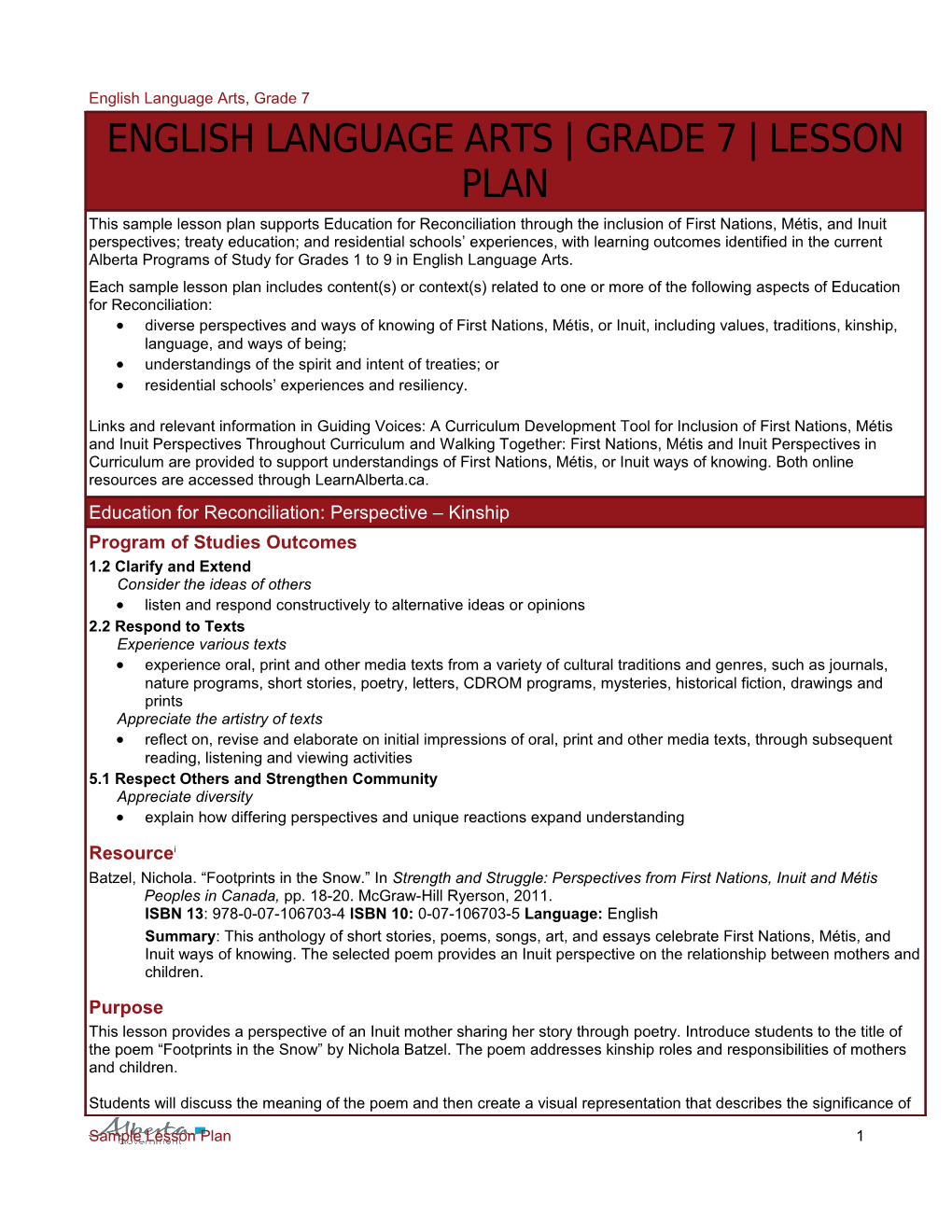English Language Arts, Grade 7
ENGLISH LANGUAGE ARTS | GRADE 7 | LESSON PLANThis sample lesson plan supports Education for Reconciliation through the inclusion of First Nations, Métis, and Inuit perspectives; treaty education; and residential schools’ experiences, with learning outcomes identified in the current Alberta Programs of Study for Grades 1 to 9 in English Language Arts.
Each sample lesson plan includes content(s) or context(s) related to one or more of the following aspects of Education for Reconciliation:
- diverse perspectives and ways of knowing of First Nations, Métis, or Inuit, including values, traditions, kinship, language, and ways of being;
- understandings of the spirit and intent of treaties; or
- residential schools’ experiences and resiliency.
Education for Reconciliation:Perspective – Kinship
Program of Studies Outcomes
1.2 Clarify and Extend
Consider the ideas of others
- listen and respond constructively to alternative ideas or opinions
Experience various texts
- experience oral, print and other media texts from a variety of cultural traditions and genres, such as journals, nature programs, short stories, poetry, letters, CDROM programs, mysteries, historical fiction, drawings and prints
- reflect on, revise and elaborate on initial impressions oforal, print and other media texts, through subsequent reading, listening and viewing activities
Appreciate diversity
- explain how differing perspectives and unique reactions expand understanding
Batzel, Nichola. “Footprints in the Snow.” In Strength and Struggle: Perspectives from First Nations, Inuit and Métis Peoples in Canada, pp. 18-20. McGraw-Hill Ryerson, 2011.
ISBN 13: 978-0-07-106703-4ISBN 10: 0-07-106703-5Language: English
Summary:This anthology of short stories, poems, songs, art, and essays celebrate First Nations, Métis, and Inuit ways of knowing. The selected poem provides an Inuit perspective on the relationship between mothers and children.
Purpose
This lesson provides a perspective of an Inuit mother sharing her story through poetry. Introduce students to the title of the poem “Footprints in the Snow” by Nichola Batzel. The poem addresses kinship roles and responsibilities of mothers and children.
Students will discuss the meaning of the poem and then create a visual representation that describes the significance of the poem.
Introduction
Discuss the meaning of the title “Footprints in the Snow.” What images come to mind when you think of footprints?
Activity/Experience
Studentsfirst engage in a silent reading of the poem to develop and extend their own ideas, opinions, and experiences and form initial individual understandings. Students record initial impressions (e.g., images, words, feelings, and questions).
Possible reflection questions may include:
- Who is walking in the snow?
- How do the footprints change throughout the poem?
- What are some of the metaphors in the poem? How do these metaphors reflect connections to Nichola Batzel’s culture?
- Why do you think the author wrote this poem? What is her main message?
- What is the writer teaching us about her perspective of the responsibility of the mother’s child-rearing in this poem?
Students use a think-pair-share strategy to discuss initial understandings with a partner to develop, extend, and revise ideas and opinions.
Students can explain how the poet uses words and structure to create mood and tone. Students can identify any shifts in mood or tone and correlations to the overall message. Students discuss the overall meaning of the poem. What life lessons can you learn from this poem?
Extension
In addition, students can create a visual that represents the meaning of the poem and includes an explanation of the significance of the visual to them.
Assessment for Student Learning
Consider multiple ways students can demonstrate their understanding of kinship roles and responsibilities of mothers and children for Inuit or other groups/collectives.
Keywords: belonging; identity; kinship; ancestors
Themes:relationship; harmony
Teacher Background[ii]
Walking Together: First Nations, Métis and Inuit Perspectives in Curriculum (Alberta Education)
- (
- (
- (education.alberta.ca/media/3615876/our-words-our-ways.pdf)
Sample Lesson Plan 1
[i]Some resources may not be authorized but are provided to identify potentially useful ideas for teaching and learning. The responsibility to evaluate these resources rests with the user. The selected resource(s) provides a perspective specific to an individual, group, or nation; they are not intended to represent the perspectives of all First Nations, Métis, or Inuit.
[ii]All website addresses listed were confirmed as accurate at the time of publication but are subject to change.
